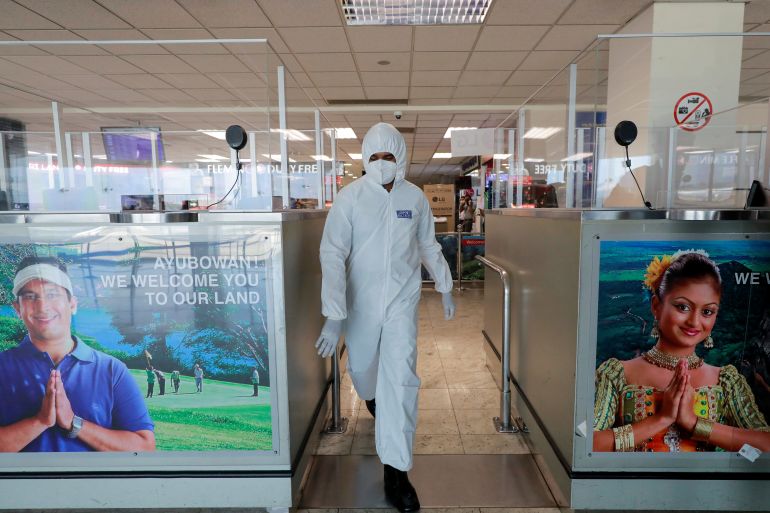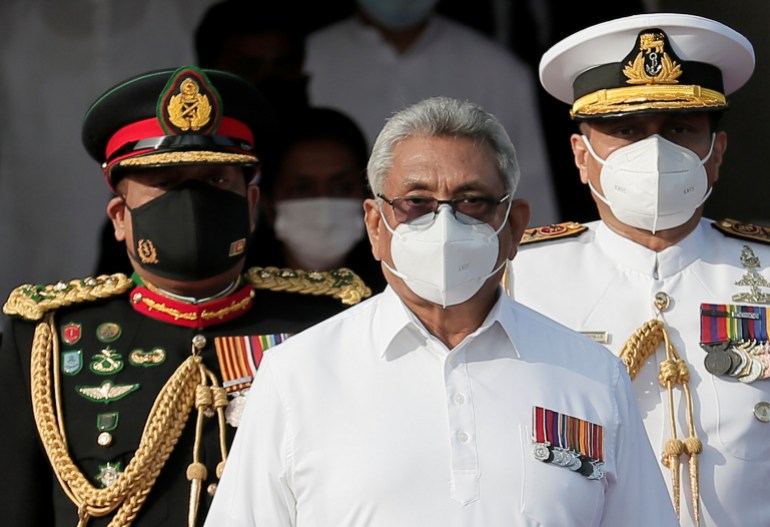Sri Lanka’s dilemma: Pay off debt or pay for milk, meds and gas
Dwindling foreign currency reserves as tourism, the main source of dollars, stays curbed has left it with few choices.

Colombo, Sri Lanka–A lone bullock cart carrying a barrel of Kerosene, a symbol of life in Sri Lanka in the 1970s, is once again a common sight on the streets of Sri Lanka’s commercial capital as dwindling foreign currency reserves have hampered the imports of everyday essentials including cooking gas.
At the root of the problem is Sri Lanka’s enormous debt. The Gotabaya Rajapaksa-led government must service $7.3bn in foreign debt this year or default on its debt, an option that could hurt its reputation, making it harder to borrow money in international markets in the future at affordable rates — a possibility that could, in turn, precipitate a severe economic crash.
Keep reading
list of 4 itemsSri Lanka central bank chief steps down as reserve crisis deepens
Sri Lanka brings back veteran central banker
Sri Lanka allows sharp rise in food prices to ease shortages
In December, the country’s foreign reserves teetered to a historic low of $1.6bn as income from foreign tourists, the key source of foreign exchange, had shrunk during the pandemic. But it received a year-end boost when the central bank drew down on a 10 billion yuan ($1.5bn) currency swap that it had agreed upon with China.
That one time swap won’t go far in boosting the country’s reserves and for Colombo, Sri Lanka’s largest city and commercial capital, it’s boiling down to a choice between servicing its debt or paying for imports of everyday needs. So far it appears that the government is committed to the former, even if that means sacrificing the needs of its citizens who are struggling for all sorts of essentials including cooking gas, milk powder, fuel and medicines.
Earlier this month, leaders of the Ceylon Chamber of Commerce, a prominent industry body, called upon the government to defer servicing bond payments and instead use scarce foreign exchange to purchase essential items like food and medicine for Sri Lankan citizens.
Vish Govindasamy, chairman of the industry body, in a statement to local media, urged the government to “allow the use of inflows of forex to ease the general public’s difficulties in obtaining essentials”. And since the majority of the country’s foreign currency comes from tourism, “we cannot afford to send the world messages of food shortage in the country, it will only be counterproductive,” he warned.
Former chairman JD Bandaranayake added that the government should focus on “mitigating hardships” and said that “the government should reschedule the payment of debt.”
So far these pleas have fallen on deaf ears as cabinet ministers and the central bank have instead been scrambling for short-term solutions, mainly currency swaps like the one it did in December. But analysts say such swaps cannot be converted easily into US dollars and are practically pointless when it comes to paying off debt.
The central bank no doubt knows that and last week it liquidated half its gold reserves to help meet international sovereign bond payments of $500m that it settled yesterday.
In late December, the government also ordered licensed commercial banks to sell 25 percent of all foreign exchange receipts to the central bank every week. Opposition member of parliament Dr Harsha de Silva warned this will further crimp the ability of commercial banks to service the needs of importers.
With commercial banks unable to predict their own foreign currency inflows, they are either in no position, or are unwilling to, open letters of credit for importers. As a result, importers who were relying on alternate arrangements, such as buying goods on deferred payments, are running out of options.
Businesses squeezed
Laugfs Gas, one of two cooking gas suppliers in the country, warned earlier in January that it was unable to import the required quantities of LP gas due to the dollar shortage.

A senior executive at a large food manufacturer who preferred not to be named due to fear of reprisal from the government, said the company’s production had halved as it can no longer import all the raw materials it requires. “We have switched to other foreign suppliers who are agreeable to alternate terms, but this has increased our costs by 35 percent,” the official told Al Jazeera. “The shortage in fertilisers has impacted harvests so local suppliers are also not able to meet our full demand.”
Small businesses are also significantly affected as they do not have much reprieve outside of the formal banking system to fund their imports.
Amjad Nazeer co-owns a store in Colombo selling premium quality nuts, seeds and healthy foods. He started the business with his family during the pandemic but is struggling to plan his supplies with all the restrictions.
“We have stopped direct imports of products because we can’t open letters of credit or transfer money to our suppliers overseas. We now rely on large scale importers who can navigate the situation better than us, but we are still finding it difficult to get certain equipment and raw materials from China due to these issues,” he told Al Jazeera.
All of this has pushed up costs by 20 to 30 percent, squeezing the company’s profit margins and forcing it to hike prices. That, however, has led to a dip in both the quantities ordered and the average order value, he said.
Other seemingly innocuous restrictions, such as a cap on overseas transactions on credit cards, have also added to Nazeer’s woes. “Credit card payments to online and social media advertising companies like Meta and Google get rejected if it exceeds $100,” says Nazeer. He now has the additional work of setting up multiple payments, each capped at $100, he says.
Exports, a source of foreign revenue, too are getting hit as forex shortages, coupled with strict import restrictions on raw materials, machinery and equipment, are handicapping production and hitting output.
Both small and large exporters are facing difficulties and delays in sourcing the required raw materials to meet customer orders. Many have had to find alternate suppliers or materials, which has driven up their production costs, hurting their competitiveness in the international market. Other expenses, like shipping and freight fees, have increased, too, adding to the cost of doing business.
Strong-arm tactics
The central bank has resorted to a variety of strong-arm tactics to attempt to maintain its artificially low peg on the dollar while accumulating the foreign currency needed to repay the country’s debts.

Some of these tactics include forcing banks to mandatorily convert money received from overseas and exporter earnings to rupees.
These strategies, however, are aggravating the shortage. Foreign currency inflows such as worker remittances have moved away from formal into informal channels where the dollar retails for 25 percent above the official rate. Remittances through formal channels fell to $271m in November 2021 – the lowest recorded since 2010, tweeted economist and migration specialist Dr Bilesha Weeraratne. That, in turn, has led to raids on money exchangers, who the government has accused of ‘black market’ transactions as they were offering a higher exchange rate to the dollar.
November2021 "formal" #mittances to #LKA was a mere USD 271 mn. Lowest recorded since 2010. Did informal remittances experience a similar decline? pic.twitter.com/NbedRYQG89
— Bilesha Weeraratne (@bilesha_w) December 21, 2021
The central bank’s directive to convert income from overseas has also upset the freelance community which provides services outside of Sri Lanka. “They freeze all my incoming earnings now until I either convert 90 percent of it to rupees or until I prove I am not receiving these funds as a business transaction,” said Y Senarath, a designer and illustrator who undertakes commissions from international clients. “It’s unfair because the official rate doesn’t even reflect reality, prices are sky high and I’m making a loss at this rate. It’s better if I find an alternate way to hold my dollar earnings than having it sent here.”
Devalue rupee?
As the country scrambles for foreign currency, there are calls from different segments of the economy to allow the rupee to devalue to more realistic levels to bring inflows back into formal channels to ease the shortage.
That by itself won’t be enough to address the shortage, warns Nishan De Mel, economist and executive director of Verité Research, a Colombo-based think-tank.
“The fundamental objective should be to reduce the shortage of dollars through preemptive debt restructuring,” he says. “As long as there is a fear that a dollar shortage will persist, there will be more demand than supply for dollars. Whatever the official price, the unofficial price will always be higher.”
His solution: a credible and transparent debt restructuring process by the government to arrest the shortage as well as fears of a future shortage.
Despite the urgency, the government of Sri Lanka has ruled out an IMF-style bailout and has instead pursued a range of other stop-gap solutions including a tea-for-debt swap with Iran last month. Colombo is also in talks with several bilateral allies including Oman, Qatar and Japan for loans to meet some of its import needs. India, which has already extended a $400m swap facility, has agreed to partially defer a $500m loan and has also promised a credit line for essential goods worth $1.5bn.
Last week President Gotabaya reached out to Beijing to restructure debt repayments in addition to a concessional credit facility to import goods. In return, Sri Lanka has promised to ease COVID-related travel restrictions for Chinese tourists, the second major source of tourists for the island state. Some of the income from them will no doubt help fuel the battered economy when it happens.